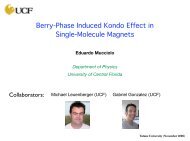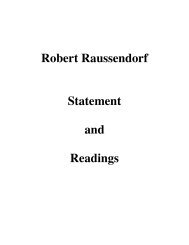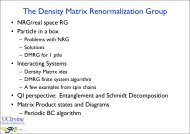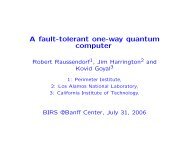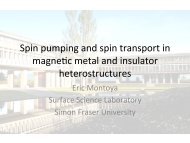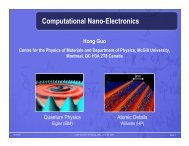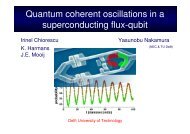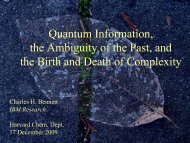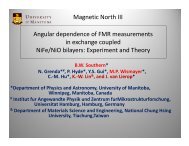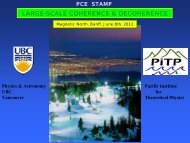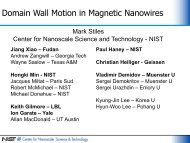PCE STAMP - Pacific Institute of Theoretical Physics
PCE STAMP - Pacific Institute of Theoretical Physics
PCE STAMP - Pacific Institute of Theoretical Physics
Create successful ePaper yourself
Turn your PDF publications into a flip-book with our unique Google optimized e-Paper software.
<strong>PCE</strong> <strong>STAMP</strong><br />
<strong>Physics</strong> & Astronomy<br />
UBC<br />
Vancouver<br />
<strong>Pacific</strong> <strong>Institute</strong><br />
for<br />
<strong>Theoretical</strong> <strong>Physics</strong>
Limitations <strong>of</strong> EFFECTIVE HAMILTONIANS-<br />
Dissipation and Decoherence<br />
P.C.E. Stamp Arrows <strong>of</strong> Time 2004 (Outing Lodge, Dec 2004)<br />
Some key notions for<br />
Thermodynamic Arrow<br />
Coarse/fine-graining<br />
“Exact” solution<br />
Quantum Arrow<br />
Unitary evolution<br />
“exact” solution<br />
decoherence<br />
All these notions<br />
(& others crucial<br />
to discussion <strong>of</strong><br />
Arrows), rely on<br />
notion <strong>of</strong><br />
EFFECTIVE<br />
HAMILTONIAN
I. Limitations <strong>of</strong> EFFECTIVE HAMILTONIANS<br />
H eff
E c<br />
Orthodox view<br />
<strong>of</strong> H eff<br />
Scale out<br />
High-E<br />
modes<br />
“Renormalisation”<br />
Ω o<br />
H eff (E c ) H eff (Ω o )<br />
The RG mantra is: RG flow<br />
fixed points<br />
|ψ i<br />
> H ij<br />
(E c<br />
) H αβ<br />
(Ω o<br />
)
MORE ORTHODOXY<br />
(E c )<br />
(Ω o )<br />
Continuing in the orthodox vein, one<br />
supposes that for a given system, there<br />
will be a sequence <strong>of</strong> Hilbert spaces,<br />
which the effective Hamiltonian and<br />
the other relevant physical operators<br />
these are effective operators) are<br />
defined.<br />
Then, we suppose, as one goes to low<br />
energies we approach the ‘real vacuum’; the approach to the fixed<br />
point tells us about the excitations about this vacuum. This is <strong>of</strong><br />
course a little simplistic- not only do the effective vacuum and the<br />
excitations change with the energy scale (<strong>of</strong>ten discontinuously, at<br />
phase transitions), but the effective Hamiltonian is in any case<br />
almost never one which completely describes the full N-particle<br />
states.<br />
Nevertheless, most believe that the basic<br />
structure is correct - that the effective<br />
Hamiltonian (& note that ALL<br />
Hamiltonians or Actions are<br />
effective) captures all the basic physics
SIDENOTE on<br />
‘EMERGENCE’ vs ‘REDUCTIONISM’<br />
The reductionist view is that all matter can be<br />
understood in terms <strong>of</strong> its ‘basic constituents’.<br />
is an atomistic point <strong>of</strong> view.<br />
The ‘emergence’ point <strong>of</strong> view says that<br />
structures <strong>of</strong> matter at higher levels, & in<br />
more complex systems, CANNOT be<br />
understood in terms <strong>of</strong> basic constituents- that they have properties<br />
that are ineluctably ‘complex’ & which cannot ever be understood in<br />
terms <strong>of</strong> elementary constituents, even in principle.<br />
NB1: Many if not most ‘emergence’ believers still<br />
nevertheless assume that matter is composed <strong>of</strong> ‘bits’<br />
(the ‘lego’ philosophy, or ‘s<strong>of</strong>t’ emergence)<br />
NB2: In fact there is no obvious end in sight to the long road<br />
towards ‘elementary constituents’. Nature may just be ‘wheels within wheels..’.
States in a glass- piled up at low E<br />
1 ST CONUNDRUM- the ‘GLASS’<br />
The simple picture <strong>of</strong> excitations<br />
perched above a vacuum gets a<br />
shock when we consider Glasses -<br />
systems with disorder &<br />
‘frustrating interactions’. We are<br />
surrounded by these! States pile<br />
at low energy, but these can’t<br />
communicate with each other.<br />
Frustrating interactions<br />
‘Frustration’ means that at low energy, any<br />
What this means is that no matter what<br />
local change must re-organize simultaneously<br />
energy or temperature one is working a vast number <strong>of</strong> states. This forces the<br />
the ground state <strong>of</strong> the spin glass Hilbert space <strong>of</strong> the effective Hamiltonian to<br />
Hamiltonian is meaningless. At finite have an ‘ultrametric’ geometry.<br />
the system can never reach the ground<br />
state, and the finite-T Hilbert space is<br />
from any ground state. At zero-T, the system splits<br />
subspaces that can never communicate with each<br />
other. Thus the effective vacuum & its structure<br />
physically meaningless. A glass can only be defined<br />
its dynamic (non-equilibrium) properties.<br />
‘Ultrametric geometry’ <strong>of</strong> a glass Hilbert space
2 ND CONUNDRUM- the HUBBARD MODEL<br />
The ‘standard model’ <strong>of</strong> condensed matter<br />
physics for a lattice system is the ‘Hubbard<br />
model’, having effective Hamiltonian at<br />
electronic energy scales given by<br />
∑<br />
i,<br />
j<br />
(<br />
†<br />
..)<br />
∑<br />
H =− t c c + hc + U n n<br />
iσ jσ i↑ i↓<br />
i<br />
This apparently simple Hamiltonian has<br />
very bizarre properties. Suppose we try to<br />
a low energy effective Hamiltonian, valid<br />
near the Fermi energy- eg., when the<br />
is near “half-filling”. We therefore assume<br />
UV Cut<strong>of</strong>f much smaller than the<br />
between the Mott-Hubbard sub-bands (we<br />
assume that U > t).<br />
The problem is that this appears to be impossible. Any attempt to write an<br />
effective Hamiltonian around the Fermi energy must deal with ‘spectral weight<br />
transfer’ from the other Hubbard sub-band- which is very far in energy from the<br />
Fermi energy. Thus we cannot disentangle high- and low-energy states. This is<br />
sometimes called UV/IR mixing.
3 RD CONUNDRUM-<br />
TOPOLOGICAL<br />
FIELD THEORIES<br />
RIGHT: A statistical<br />
flux attaches itself<br />
to an electron to<br />
make an ‘anyon’-<br />
here on a lattice<br />
It is now apparent that the basic theories required in<br />
string theory & quantum field theory will be<br />
in nature. Theories like Chern-Simons theories have<br />
anyonic excitations & topologically different but<br />
degenerate vacua. In string theory it is hard to get rid <strong>of</strong><br />
tachyons, which create the analogue <strong>of</strong> a lattice potential<br />
the strings, leading to the complexity <strong>of</strong> the famous<br />
‘WAH’ butterfly (left); once<br />
fluctuations & coupling to<br />
bosons are added, we get a<br />
fractal phase diagram .<br />
A key feature <strong>of</strong> all <strong>of</strong> these<br />
theories, and <strong>of</strong> any noncommutative<br />
gauge theory, is<br />
the same UV/IR mixing we<br />
saw in the Hubbard model- ie.,<br />
no well-defined effective low-E<br />
action or Hamiltonian.
II. ENTANGLEMENT & DECOHERENCE<br />
Take 2 systems (A & B) that have once interacted, but are now<br />
separated, & whose states are still entangled. It makes no sense<br />
to write down 2 separate effective Hamiltonians, one for each- a<br />
complete description <strong>of</strong> A can not be given by a Hamiltonian<br />
which operates only in the Hilbert space <strong>of</strong> the variables <strong>of</strong> A,<br />
no matter what the cut-<strong>of</strong>fs may be.
SOLID-STATE QUBITS: <strong>Theoretical</strong> Designs & Experiments<br />
Here are a few:<br />
(1) Superconducting SQUID<br />
qubits (where qubit states are flux<br />
states); all parameters can be<br />
controlled.<br />
(2) Magnetic molecule qubits (where an<br />
easy axis anisotropy gives 2 low<br />
energy spin states, which communicate via<br />
tunneling, and couple via exchange or<br />
dipolar interactions. Control <strong>of</strong><br />
individual qubit fields is easy in<br />
principle- interspin couplings<br />
less so...<br />
S 1<br />
S 2<br />
S 1<br />
Mn IV<br />
Mn III<br />
J'<br />
S<br />
-J<br />
(3) Spins in semiconductors (or in Q Dots).<br />
Local fields can be<br />
partially controlled, &<br />
the exchange coupling<br />
is also controllable.<br />
Mn IV<br />
Mn III<br />
S<br />
S 2<br />
S 1<br />
J'<br />
-J<br />
S 2<br />
Mn IV<br />
Mn III<br />
S
DECOHERENCE DYNAMICS from an EFFECTIVE H<br />
Consider the following H eff :<br />
H (Ω ο ) = { [∆τ + exp(-i Σ k α k .σ k ) + H.c.] + ε ο τ z (qubit)<br />
+ τ z ω k .σ k + h k .σ k (bath spins)<br />
+ inter-spin interactions<br />
At first glance a solution <strong>of</strong> this seems very forbidding. However it turns out one can solve<br />
for the reduced density matrix <strong>of</strong> the central spin in all interesting parameter regimes- &<br />
the decoherence mechanisms are easy to identify:<br />
(i) Noise decoherence: Random phases added to different Feynman paths by<br />
the noise field.<br />
(ii) Precessional decoherence: the phase<br />
accumulated by bath spins between qubit flips.<br />
(iii) Topological Decoherence: The phase<br />
induced in the bath spin dynamics by the<br />
qubit flip itself<br />
Noise decoherence source<br />
USUALLY PRECESSIONAL<br />
DECOHERENCE DOMINATES<br />
Precessional decoherence<br />
This leads to the very interesting result that one<br />
can have decoherence dominated by processes<br />
which cause little or no dissipation
3 rd PARTY DECOHERENCE<br />
This is fairly simple- it is decoherence in the dynamics <strong>of</strong> a<br />
system A (coordinate Q) caused by indirect entanglement<br />
with an environment E- the entanglement is achieved via a<br />
3 rd party B (coordinate X).<br />
Ex: Buckyball decoherence<br />
Consider the 2-slit<br />
buckyballs. The<br />
coordinate Q <strong>of</strong> the buckyball does not couple directly to the vibrational<br />
{qk } <strong>of</strong> the buckyball- by definition. However BOTH couple to the slits in<br />
system, in a distinguishable way.<br />
Note: the state <strong>of</strong> the 2 slits, described by a coordinate X, is irrelevantnot<br />
need to change at all. We can think <strong>of</strong> it as a scattering potential,<br />
by a system with infinite mass (although recall Bohr’s response to<br />
which includes the recoil <strong>of</strong> the 2 slit system). It is a PASSIVE 3 rd party.<br />
ACTIVE 3 rd PARTY: Here the system state correlates with the 3 rd party, which then goes on to<br />
environment to correlate with Q. We can also think <strong>of</strong> the 3 rd party X as PREPARING the states <strong>of</strong> both<br />
and environment. Alternatively we can think <strong>of</strong> the system and the environment as independently<br />
state <strong>of</strong> X. In either case we see that system and environment end up being<br />
correlated/entangled.<br />
Note the final state <strong>of</strong> X is not necessarily relevant- it can be changed in an<br />
arbitrary way after the 2 nd interaction <strong>of</strong> X. Thus X need not be part <strong>of</strong> the<br />
environment. Note we could also have more than one intermediary- ie., X, Y,<br />
etc.- with correlations/entanglement are transmitted along a chain (& they<br />
can wiped out before the process is finished).
REMARKS<br />
R1: One could argue that despite all this, the idea that we can still think <strong>of</strong> matter as made<br />
<strong>of</strong> ‘elementary constituents’ (the lego philosophy) is nevertheless intact.<br />
If so, one would like to know how to formulate this in physical theory- at the present time<br />
the fundamental formulation <strong>of</strong> the properties <strong>of</strong> any physical system is in terms <strong>of</strong> an<br />
effective Hamiltonian or effective action- and this poses the problems discussed herein.<br />
R2: Despite the literature and the beliefs <strong>of</strong> reductionists in the particle physics community,<br />
these are not just problems <strong>of</strong> condensed matter physics- they arise in high energy physics as well.<br />
Notice that whereas the IR / UV mixing comes in in condensed matter systems<br />
typically in the presence <strong>of</strong> a lattice, this is not necessary- in non-commutative gauge<br />
theory or open string theory there is no lattice. In any case- since all Hamiltonians are<br />
effective, the problems we address are generic to all ‘many-body’ quantum theories, in<br />
condensed matter, particle theory, or quantum gravity.<br />
R3: Some <strong>of</strong> the problems discussed so far exist in a classical theory. However features<br />
like IR / UV mixing seem to be quantum mechanical. And <strong>of</strong> course, the ineluctable role <strong>of</strong><br />
entanglement is entirely a QM feature.<br />
Note that some formulations <strong>of</strong> QM make the description <strong>of</strong> any quantum system dependent<br />
on macroscopic objects, and their entanglement with them (eg., Copenhagen/Bohr).<br />
R4: The idea <strong>of</strong> ‘Emergence’ results, in what we discuss above, from the impossibility<br />
mapping from one effective Hamiltonian to another, even for the same system. ‘S<strong>of</strong>t’<br />
is basically the logo philosophy. Hard emergence denies even this, and says that the<br />
properties <strong>of</strong> the microsystem may even be dependent on those <strong>of</strong> the macrosystem.
TALK: see<br />
http://physics.ubc.ca/~stamp



